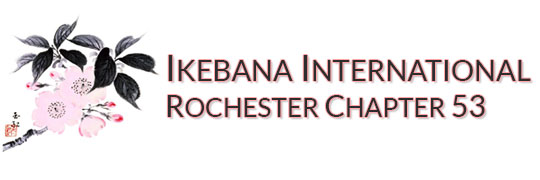
There are many kinds of ikebana arrangements in the Ichiyo School of Ikebana. Most are tabletop size. But some are so large, they only fit on a stage. And some are so small that they fit only into a corner of a small bathroom counter and are considered miniature. The stage ikebana can be also very complex with many materials, colors, and textures. And some, are very simple with few materials. The larger arrangements can be compared to a Mahler symphony. Other arrangement are much more simple, but still very rich and have amazing depth–much like a Chopin nocturne of ballad.
The arrangements in this post are of the more simple, but very rich type of arrangements. They are all the arrangements of Elaine Jo, an Executive Master of the Ichiyo School of Ikebana. She was gracious enough to share these arrangements in order to show the rich depth of beauty in simple arrangements.

In this striking arrangement, there are only three elements–the solid purple iris, the greenery and the lighter, white flowers. With the dark background, the colors come out dramatically. This arrangement shows how easy and difficult it can be to make these simple arrangements. One has to use their sense of beauty which usually only comes from years of practicing ikebana. Making these simple but rich arrangements successfully, is not as easy as it may seem. Making them is easy in terms of the number of materials in the arrangement, but they are difficult in terms of making the few materials come together in an arrangement that makes the viewer speechless!
These next arrangements reveal the concept of “wabi-sabi.” One arrangement uses a container that was a “failed” attempt at making a pottery vase. The other arrangement uses a woven basket. “Wabi-sabi” is a Japanese term translated into “wisdom in natural simplicity.” In the traditional Japanese understanding of aesthetics, wabi-sabi refers to appreciating beauty that is “imperfect, impermanent, and incomplete in nature.” In the grey vase arrangement, there is the simple use of green material and one flower to match the simple, and “imperfect” pottery vase. Nonetheless, despite the few materials, it is very well balanced. One can look at this arrangement for a long time and never be unsatisfied. The other basket arrangement uses a dried leaf which can be understood as an example of the impermanence of life. It also has one flower.



This next arrangement simply uses one material–flowering azalea in stacked tin containers. It shows a simple balanced arrangement which uses the containers as part of the arrangement. This is an important concept in ikebana arrangements–to make sure that the container is a complimentary component of the arrangement. This is similar to the practice of bonsai where the container holding the tree must compliment the tree’s appearance. Also, when bonsai is displayed, there can also be small companion plant set close to the bonsai to compliment it. Both would not be as complete without the other.
Some arrangements may be so simple as to only use one leaf or flower. The following two arrangements are examples of this but they both take advantage of using a non-living materials–paper. Some arrangements will use dry materials such as the third arrangement which uses a dried leaf along with a single flower as show above. There are many things that an ikebana arrangement may use besides living materials. The limits are only in the mind of the one making the arrangement.


This final arrangement is ending this blog on a happy, note. It is another example of using few materials, but also in a container which matches these materials. The yellow of the tulips match the yellow container. The red lines in the container match the red flowers. There are only two materials in this arrangement the tulips with its associated greenery and the red flowers. So, it is simple in terms of the number of materials. However, it is more complex than the above arrangements in that there is more going on with the containers interaction of red spots and lines.

The waviness of the container and the tulip leaves also add significant movement. How could anyone be depressed after seeing this arrangement with all its energy and flow? Simple arrangements are an easy way to add beauty to one’s life.
